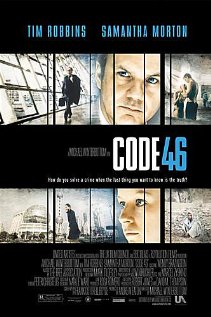

Synopsis: William Geld (Tim Robbins) is a fraud investigator seeking to discover who is releasing unauthorized papels (one-time papers granting permission to engage in some activity) from a security firm in Shanghai. In the course of his investigation, he meets Maria Gonzales (Samantha Morton), the source of the security breaches. Under the influence of an empathy virus that assists his ability as an investigator, he falls in love with Maria in the 24 hours that he is on assignment. Upon his return to his family in Seattle, he learns that there have been consequences due to additional security breaches and is sent back to settle the matter. He finds Maria in a hospital, her pregnancy terminated and her memory of him erased. It seems that Maria is genetically identical to William's biological mother, who he never met, so their union is a violation of Code 46, an anti-incest law passed in the wake of widespread cloning of embryos in the past. They conspire to escape from the controlled world to the outside, where Maria has experience, but it is not to be. In the end, William is reprogrammed back into life on the inside with his memory of Maria erased, while she settles into a bleak life on the outside with her memory of William.
The World of Code 46: In the world as seen in this movie, there are two kinds of people. The people who work for The Man (having "cover" in the language of the film) seem to have it all: they are healthy, affluent world travelers with engaging careers and all manner of consumer goods. The people on the outside, and this seems to be most of humanity, live in shantytowns as beggars. The film was shot on a low budget that made an extensively designed imaginary world out of reach, so it is shot on location all around the world with a few changes in information technology, computer displays, and biometric security to let us know that it is set somewhat in the future. There is a nod to the world of Blade Runner: everyone in the film speaks English with bits of other languages (Spanish, French, Arabic, Italian, and Mandarin) thrown in.
The world of the people on the inside is governed by a kind of fusion of a corporation and a world government, the Sphynx. The Sphynx knows best and does not need to give its reasons. Employment, travel, relationships, and other aspects of life are governed by the decisions of the Sphynx. There are a large number of rules, and a very streamlined justice system that is free to selectively erase the memories of people on the inside, or even to banish them to the outside.
 |
 |
 |
 |
 |
IVF/Cloning: An important element of the plot is the production of people by in vitro fertilization (IVF), with subsequent cloning of some of the embryos into multiple embryos. William Geld discovers that his lover Maria Gonzales is one of a batch of twenty embryos from a single fertilization and cloning. The embryos from this batch have been implanted into surrogate mothers, and have been born over a considerable time period. William learns that his lover is genetically identical to his biological mother, who he never met. As William is considerably older than Maria, the twenty embryos must have been used over three or four decades. The reason for this is never explained.
Scientific accuracy: The first human being conceived by IVF, Louise Joy Brown, was born in 1978. IVF is frequently used to create pregnancies in women who are infertile due to blocked Fallopian tubes. The technology is well established. Hundreds of thousands of children have been born as a result of IVF. The stretch here is human cloning. Many different species of mammals have been cloned, some from embryonic cells, and some from somatic cells, which is harder. To date, ethical considerations have prevented attempts at human cloning, because the procedure would serve no medical purpose and it poses risks. Nevertheless, it certainly seems to be technically possible. The IVF/cloning element of this movie is highly accurate scientifically, even though the need for this practice is unclear.
Extent of genetic relationship between people: In the opening sequence, there is a text explanation of the laws against incest:
any human being who shares the same nuclear gene set as another human being is deemed to be genetically identical.
the relations of one are the relations of all.
due to IVF, DI embryo splitting and cloning techniques it is necessary to prevent any accidental or deliberate genetically incestuous reproduction.
therefore:
i. all prospective parents should be genetically screened before conception.
if they have 100%, 50% or 25% genetic identity, they are not permitted to conceive.
ii. if the pregnancy is unplanned, the foetus must be screened, and pregnancy resulting from 100%, 50% or 25% genetically related parents must be terminated immediately.
iii. if the parents were ignorant of their genetic relationship then medical intervention is authorised to prevent any further breach of code 46
iv. if the parents knew they were genetically related prior to conception it is a criminal breach of code 46
Scientific accuracy: Children derive 50% of their genetic material from each parent, so a comparison between the genomes of a parent and a child will reveal 50% identity. Siblings will be an average of 50% identical to each other but can be more. There are three relationships with an average of 25% identity: children and their grandparents, uncles and aunts with their nieces and nephews, and half-siblings. First cousins on average share 12.5% identity, and first-cousin marriages are illegal in most states. So the Code 46 laws are less stringent than marriage laws in most states at the present time, although their enforcement is more draconian.
Engineered viruses: William Geld is primed for a work-related extramarital affair due to an occupational hazard: as a fraud investigator, he has been deliberately infected with a performance-enhancing genetically-engineered "empathy virus" that improves his intuition and connection with other people. This leads him to a brief affair with Maria Gonzales, rather than turning her in for fraud. There is a virus that confers perfect pitch. Maria tells him that she tried the Mandarin Chinese virus once; it let her speak Mandarin, and people understood her, but she didn't understand what she was saying. There are other viruses mentioned in passing.
Scientific accuracy: The general concept of an infectious agent that alters behavior is well established. Familiar examples include rabies and toxoplasmosis, two infectious agents that alter behavior in ways that make it most likely that the host will transmit the agent to another host. The concept that a virus could increase someone's capacity for empathy is plausible, but in the movie this goes a bit far, as William's increased empathy lets him guess people's security passwords, a feat of ridiculous mind-reading that has nothing to do with empathy. The film gets only partial credit on the science here.
Tissue regeneration: Maria has had a finger graft to replace a lost finger, regrown from her own tissue.
Scientific accuracy: There have been several reports of children and adults who have regenerated the very tip of a finger provided that the wound was not closed surgically. There have been significant advances in stem cell therapy in recent years. It is not inconsistent with known science to suggest that in the future, people may be able to regenerate lost tissues.
Genetic susceptibility to an infectious agent: Maria provides forged papers for a friend in Shanghai who has always wanted to visit Delhi, but who has been denied permission for the past eight years. He travels to Delhi but dies within a week from Ward's Disease, an imaginary infectious agent that causes a hemorrhagic fever. The population of Delhi is immune. The Sphynx knew of the man's genetic susceptibility, which was the reason that his request to travel was denied.
Scientific accuracy: Genetic resistance or susceptibility to specific infectious agents is well known. There is genetic variation in human populations that confers resistance to HIV, for example. There are many other examples.
Memory erasure: The Sphynx has the ability to erase memories in a highly precise way. When Maria has her pregnancy terminated, they erase her memory of William, and further program her to make his touch painful to her. In the end William has all of his memory of Maria erased and returns to his married life.
Scientific accuracy: There has been some recent progress in changing the emotional content of traumatic memories through a process that requires drug therapy and the cooperation of the patient. Several drugs in common use prevent the incorporation of short-term memory into long-term memory (e.g. Propofol). The neurobiology of memory is a field of active investigation, but it is not yet possible to erase precisely specified memories from a person, even if they are willing to cooperate. As this does not seem entirely impossible, we will give the film a pass on the science here, considering it to be speculative.
Summary: Other than the mind-reading, the science here is either in the realm of the known or the speculative, giving this film a three-flask rating.
 |
 |
 |
 |
 |
Tooth Fairy - avoid needless suffering
first exit (voiceover) - If we had enough information, we could predict the consequences of our actions. Would you want to know? If you kiss that girl, if you talk to that man, if you take that job or marry that woman or steal that papel? If we knew what would happen in the end, would we ever be able to take the first step, to make the first move?
What are the ethical issues in human cloning? Benefits? Risks?
What are the legal issues in human cloning?
What are the social issues?
The film makes us think: would we rather be William, happily reprogrammed and on the inside, or Maria, with her memory of William but living on the outside where dreams can come true?
Do we want an all-knowing, all-powerful state intervening on our behalf without informing us of the reasons?
How does this compare to physicians who do not want to release test results to patients, but rather choose to "interpret" them?
The big unanswered question: why was all the IVF/cloning done?
Beyond that, the movie is thought-provoking on ELSI issues without offering simplistic answers, as much as we can expect from a movie.